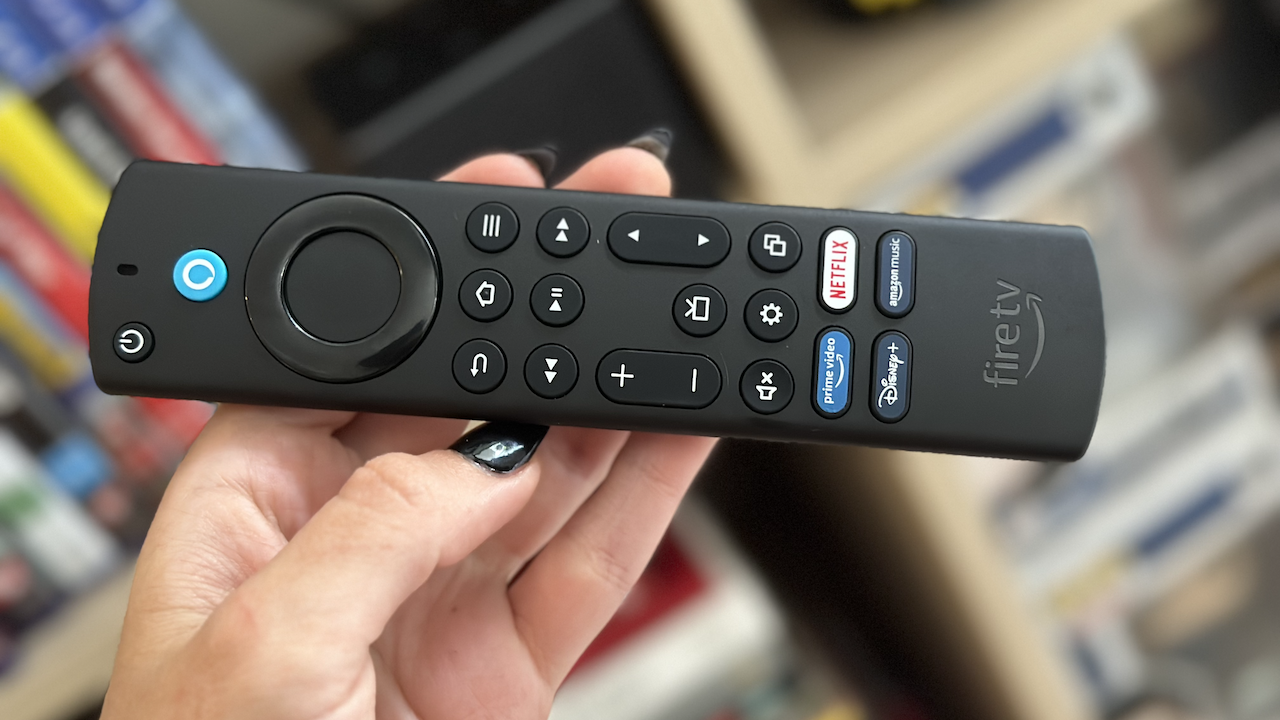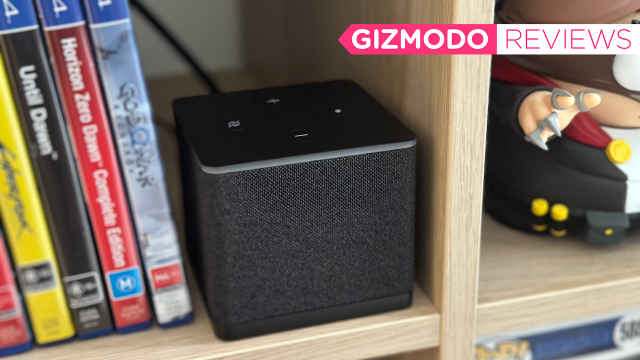In my bedroom sits a not-so-smart TV, a cheap one, picked up from Kogan when I needed a television ASAP. This TV is now a little more smart, enabled by the new Apple TV 4K. It was this TV I had every intention of connecting to the Amazon Fire TV Cube, but it actually had something the $6,500 TV in my loungeroom didn’t.
So that’s where it went.
That something was NJPW World – which is the streaming app for the New Japan Pro Wrestling. Now before you comment, this is because my partner is (unfortunately) a wrestling fan. We’ve still got nine months left on our 12-month lease (also unfortunately).
But, it allowed me to use the gadget on an 8K, 75-inch TV, which really put it, visually, to the test.
Amazon Fire TV Cube
Amazon announced the Fire Cube in September. It’s the company’s third-generation streaming box, one that boasts an improved octa-core processor and Super Resolution upscaling so you can watch HD content in a 4K-like sharpness. Amazon also promises better audio quality with the Fire TV Cube, due in part to its support of Dolby Atmos audio, plus Wi-Fi 6e support.
There’s also a USB port, Ethernet and HDMI built into the device (you have to purchase the HDMI separately, though), so it also works as a centralised entertainment hub. If you want, you can also use the USB port to add a compatible webcam and video chat through Alexa.
Let’s get ready to rumble!
Setup is super easy. You plug it into your TV and to power, select the appropriate HDMI channel, choose your language, connect to Wi-Fi, scan for updates, complete those updates, sign in using your Amazon account (or set one up), complete set up on your TV or via the web, connect the Fire Cube to other devices such as soundbars or speakers, allow Alexa to control devices (the remote is Alexa-enabled but you can always add your smart home devices if they’re Amazon, too), fiddle with parental controls and then finally, choose apps to download.
Apps aren’t all downloaded, but there’s an easy sort of ‘click to instal’ option – stating with most popular, such as Netflix, Disney+, then split into sections like entertainment, sport, news or local (ie 9Now), but once downloaded, you still have to log in, even if logged in on via the TV’s operating system.
And look, this is actually fine from a privacy perspective, just annoying and time-consuming. Of course, Prime Video is installed and logged in as you already signed into the Amazon Fire TV Cube using your Prime details.
While the NJPW World app is there, Australian streaming service Binge isn’t. Annoying, considering The Last of Us finally dropped today and I’d have loved to watch it through the Cube.

Babyface and heel
The Amazon Fire TV Cube is good. It’s simple to use, searching for apps is easy, there’s no noticeable lag (given you’re using a third party device) and most importantly, the user interface isn’t very Amazon.
I’ve previously complained about how bad Amazon’s user interface is on its Echo Show 15, which although is not as ugly as its website, is still pretty horrendous. With the Fire Cube, Amazon has made software that looks quite nice. It’s got nothing on LG’s OS, but it is user-friendly and easy on the eyes.
It’s also a big step up from the Fire TV, most of this is seen when streaming something that showcases Dolby Atmos audio. It’s also very obviously 2X as powerful as Fire TV Stick 4K Max.
The device itself is cute. It’s a 86mm x 86mm x 77mm almost cube and it only weighs 513g.
Also good is the remote, which does all the things you’d want and even allows you to use Alexa to screen demands at the TV.

The remote included, however, isn’t Amazon’s best one.
The Amazon Fire TV Cube also has its downside, mostly: why would anyone want this in 2023 when all TVs are smart?
As is the case with the Apple TV 4K, there’s a limited amount of people that would go out and buy an Amazon Fire Cube. It’s mostly going to be those without a smart TV looking for a cheap, but reliable way to make their TV smart.
But there’s also a case for getting one if your TV is already smart.
Why would you buy it if your TV is smart? Well, if you’re an Alexa house, and you want to keep as much of your life as you possibly can within Amazon’s walled garden, the Fire Cube is for you. I can’t oversell how smart this thing is thanks to Alexa and being able to voice control everything.
There’s also the whole reason this device is in my lounge room – it had something that my TV didn’t.
Clean finish
The Amazon Fire Cube is an odd offering in 2023. Something like this made sense when it was first introduced, because smart TVs weren’t really a thing yet and people wanted to watch shows via the internet. Nine years ago (when the fist Fire Stick came out) it still made sense because smart TVs still weren’t ubiquitous. In 2023, though, the market is relatively small, because now most people have a TV that can download apps and play streaming services.
The top and the bottom of it is that the Amazon Fire Cube is a great way to make your dumb TV smart. It’s lacking some of the features the Apple TV 4K has, but not everyone owns an iPhone to get the most out of the Apple streaming device, either.
At the risk of repeating myself, the Amazon Fire TV Cube does exactly what you’d expect and it does it well. It’s a good enough option if you’re looking for a third-party streaming/entertainment hub.
